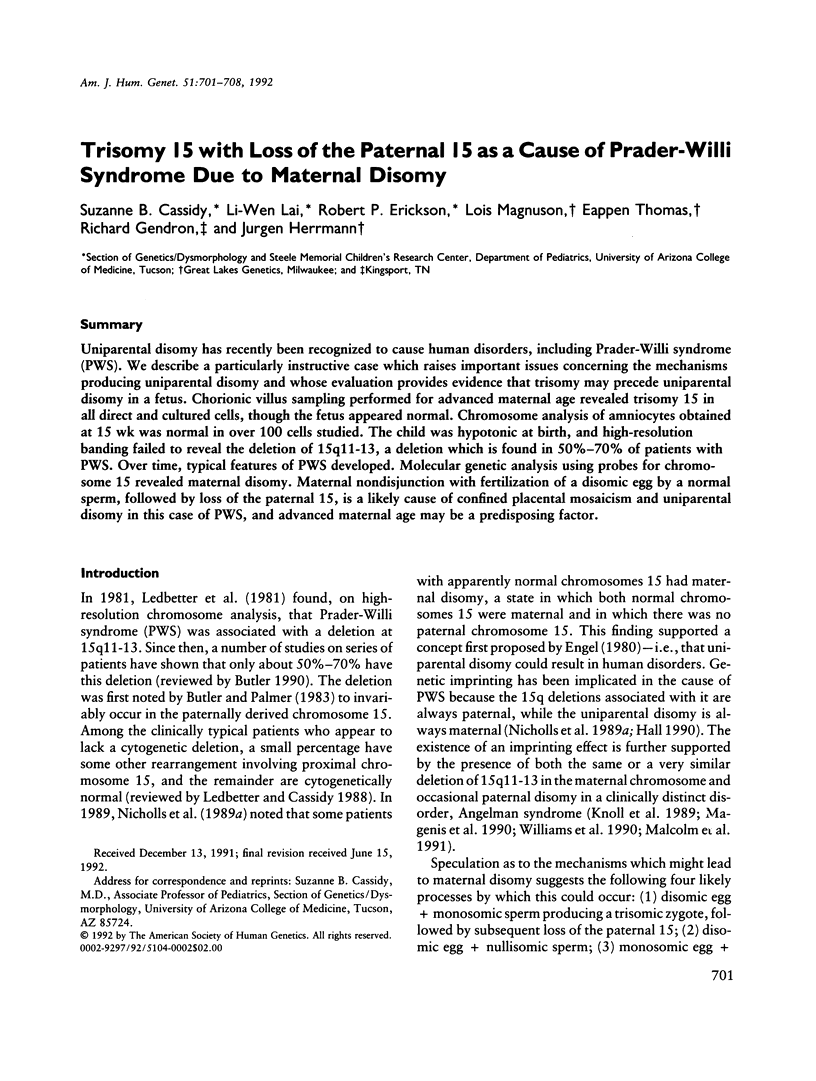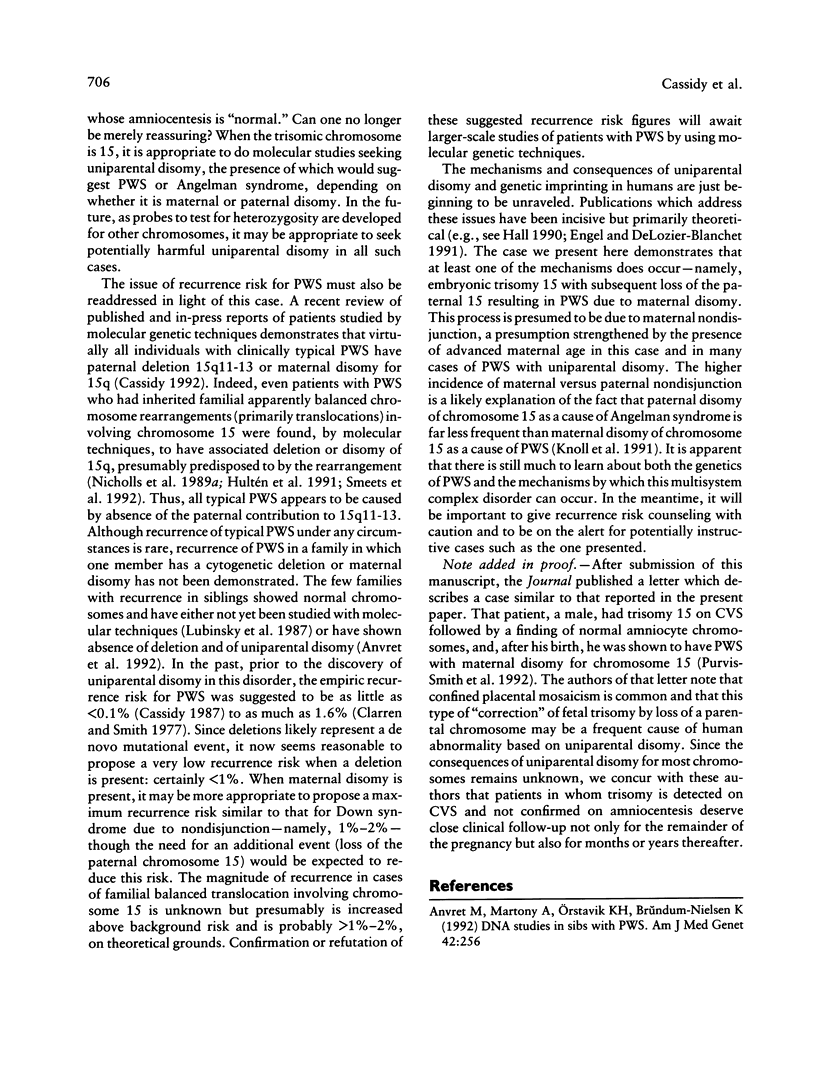Abstract
Uniparental disomy has recently been recognized to cause human disorders, including Prader-Willi syndrome (PWS). We describe a particularly instructive case which raises important issues concerning the mechanisms producing uniparental disomy and whose evaluation provides evidence that trisomy may precede uniparental disomy in a fetus. Chorionic villus sampling performed for advanced maternal age revealed trisomy 15 in all direct and cultured cells, though the fetus appeared normal. Chromosome analysis of amniocytes obtained at 15 wk was normal in over 100 cells studied. The child was hypotonic at birth, and high-resolution banding failed to reveal the deletion of 15q11-13, a deletion which is found in 50%-70% of patients with PWS. Over time, typical features of PWS developed. Molecular genetic analysis using probes for chromosome 15 revealed maternal disomy. Maternal nondisjunction with fertilization of a disomic egg by a normal sperm, followed by loss of the paternal 15, is a likely cause of confined placental mosaicism and uniparental disomy in this case of PWS, and advanced maternal age may be a predisposing factor.
Full text
PDF







Images in this article
Selected References
These references are in PubMed. This may not be the complete list of references from this article.
- Armour J. A., Povey S., Jeremiah S., Jeffreys A. J. Systematic cloning of human minisatellites from ordered array charomid libraries. Genomics. 1990 Nov;8(3):501–512. doi: 10.1016/0888-7543(90)90037-u. [DOI] [PubMed] [Google Scholar]
- Butler M. G., Palmer C. G. Parental origin of chromosome 15 deletion in Prader-Willi syndrome. Lancet. 1983 Jun 4;1(8336):1285–1286. doi: 10.1016/s0140-6736(83)92745-9. [DOI] [PMC free article] [PubMed] [Google Scholar]
- Butler M. G. Prader-Willi syndrome: current understanding of cause and diagnosis. Am J Med Genet. 1990 Mar;35(3):319–332. doi: 10.1002/ajmg.1320350306. [DOI] [PMC free article] [PubMed] [Google Scholar]
- Cassidy S. B. Recurrence risk in Prader-Willi syndrome. Am J Med Genet. 1987 Sep;28(1):59–60. doi: 10.1002/ajmg.1320280109. [DOI] [PubMed] [Google Scholar]
- Clarren S. K., Smith D. W. Prader-Willi syndrome. Variable severity and recurrence risk. Am J Dis Child. 1977 Jul;131(7):798–800. doi: 10.1001/archpedi.1977.02120200080018. [DOI] [PubMed] [Google Scholar]
- Cox N. J., Mela A. P., Zmijewski C. M., Spielman R. S. HLA-DR typing "at the DNA level": RFLPs and subtypes detected with a DR beta cDNA probe. Am J Hum Genet. 1988 Dec;43(6):954–963. [PMC free article] [PubMed] [Google Scholar]
- Donlon T. A., Lalande M., Wyman A., Bruns G., Latt S. A. Isolation of molecular probes associated with the chromosome 15 instability in the Prader-Willi syndrome. Proc Natl Acad Sci U S A. 1986 Jun;83(12):4408–4412. doi: 10.1073/pnas.83.12.4408. [DOI] [PMC free article] [PubMed] [Google Scholar]
- Engel E. A new genetic concept: uniparental disomy and its potential effect, isodisomy. Am J Med Genet. 1980;6(2):137–143. doi: 10.1002/ajmg.1320060207. [DOI] [PubMed] [Google Scholar]
- Engel E., DeLozier-Blanchet C. D. Uniparental disomy, isodisomy, and imprinting: probable effects in man and strategies for their detection. Am J Med Genet. 1991 Sep 15;40(4):432–439. doi: 10.1002/ajmg.1320400411. [DOI] [PubMed] [Google Scholar]
- Francomano C. A., Cutting G. R., McCormick M. K., Chu M. L., Timpl R., Hong H. K., Antonarakis S. E. The COL6A1 and COL6A2 genes exist as a gene cluster and detect highly informative DNA polymorphisms in the telomeric region of human chromosome 21q. Hum Genet. 1991 Jun;87(2):162–166. doi: 10.1007/BF00204174. [DOI] [PubMed] [Google Scholar]
- Hall J. G. Genomic imprinting: review and relevance to human diseases. Am J Hum Genet. 1990 May;46(5):857–873. [PMC free article] [PubMed] [Google Scholar]
- Hassold T., Warburton D., Kline J., Stein Z. The relationship of maternal age and trisomy among trisomic spontaneous abortions. Am J Hum Genet. 1984 Nov;36(6):1349–1356. [PMC free article] [PubMed] [Google Scholar]
- Hultén M., Armstrong S., Challinor P., Gould C., Hardy G., Leedham P., Lee T., McKeown C. Genomic imprinting in an Angelman and Prader-Willi translocation family. Lancet. 1991 Sep 7;338(8767):638–639. doi: 10.1016/0140-6736(91)90652-6. [DOI] [PubMed] [Google Scholar]
- Knoll J. H., Glatt K. A., Nicholls R. D., Malcolm S., Lalande M. Chromosome 15 uniparental disomy is not frequent in Angelman syndrome. Am J Hum Genet. 1991 Jan;48(1):16–21. [PMC free article] [PubMed] [Google Scholar]
- Knoll J. H., Nicholls R. D., Magenis R. E., Graham J. M., Jr, Lalande M., Latt S. A. Angelman and Prader-Willi syndromes share a common chromosome 15 deletion but differ in parental origin of the deletion. Am J Med Genet. 1989 Feb;32(2):285–290. doi: 10.1002/ajmg.1320320235. [DOI] [PubMed] [Google Scholar]
- Ledbetter D. H., Riccardi V. M., Airhart S. D., Strobel R. J., Keenan B. S., Crawford J. D. Deletions of chromosome 15 as a cause of the Prader-Willi syndrome. N Engl J Med. 1981 Feb 5;304(6):325–329. doi: 10.1056/NEJM198102053040604. [DOI] [PubMed] [Google Scholar]
- Lubinsky M., Zellweger H., Greenswag L., Larson G., Hansmann I., Ledbetter D. Familial Prader-Willi syndrome with apparently normal chromosomes. Am J Med Genet. 1987 Sep;28(1):37–43. doi: 10.1002/ajmg.1320280106. [DOI] [PubMed] [Google Scholar]
- Magenis R. E., Toth-Fejel S., Allen L. J., Black M., Brown M. G., Budden S., Cohen R., Friedman J. M., Kalousek D., Zonana J. Comparison of the 15q deletions in Prader-Willi and Angelman syndromes: specific regions, extent of deletions, parental origin, and clinical consequences. Am J Med Genet. 1990 Mar;35(3):333–349. doi: 10.1002/ajmg.1320350307. [DOI] [PubMed] [Google Scholar]
- Malcolm S., Clayton-Smith J., Nichols M., Robb S., Webb T., Armour J. A., Jeffreys A. J., Pembrey M. E. Uniparental paternal disomy in Angelman's syndrome. Lancet. 1991 Mar 23;337(8743):694–697. doi: 10.1016/0140-6736(91)90278-w. [DOI] [PubMed] [Google Scholar]
- Nakamura Y., Gillilan S., O'Connell P., Leppert M., Lathrop G. M., Lalouel J. M., White R. Isolation and mapping of a polymorphic DNA sequence pYNH24 on chromosome 2 (D2S44). Nucleic Acids Res. 1987 Dec 10;15(23):10073–10073. doi: 10.1093/nar/15.23.10073. [DOI] [PMC free article] [PubMed] [Google Scholar]
- Nicholls R. D., Knoll J. H., Glatt K., Hersh J. H., Brewster T. D., Graham J. M., Jr, Wurster-Hill D., Wharton R., Latt S. A. Restriction fragment length polymorphisms within proximal 15q and their use in molecular cytogenetics and the Prader-Willi syndrome. Am J Med Genet. 1989 May;33(1):66–77. doi: 10.1002/ajmg.1320330109. [DOI] [PubMed] [Google Scholar]
- Purvis-Smith S. G., Saville T., Manass S., Yip M. Y., Lam-Po-Tang P. R., Duffy B., Johnston H., Leigh D., McDonald B. Uniparental disomy 15 resulting from "correction" of an initial trisomy 15. Am J Hum Genet. 1992 Jun;50(6):1348–1350. [PMC free article] [PubMed] [Google Scholar]
- Rich D. C., Witkowski C. M., Summers K. M., van Tuinen P., Ledbetter D. H. Highly polymorphic locus D15S24 (CMW-1) maps to 15pter-q13. [HGM9 provisional no. D15S24]. Nucleic Acids Res. 1988 Sep 12;16(17):8740–8740. doi: 10.1093/nar/16.17.8740. [DOI] [PMC free article] [PubMed] [Google Scholar]
- Robinson W. P., Bottani A., Xie Y. G., Balakrishman J., Binkert F., Mächler M., Prader A., Schinzel A. Molecular, cytogenetic, and clinical investigations of Prader-Willi syndrome patients. Am J Hum Genet. 1991 Dec;49(6):1219–1234. [PMC free article] [PubMed] [Google Scholar]
- Simoni G., Brambati B., Danesino C., Rossella F., Terzoli G. L., Ferrari M., Fraccaro M. Efficient direct chromosome analyses and enzyme determinations from chorionic villi samples in the first trimester of pregnancy. Hum Genet. 1983;63(4):349–357. doi: 10.1007/BF00274761. [DOI] [PubMed] [Google Scholar]
- Spence J. E., Perciaccante R. G., Greig G. M., Willard H. F., Ledbetter D. H., Hejtmancik J. F., Pollack M. S., O'Brien W. E., Beaudet A. L. Uniparental disomy as a mechanism for human genetic disease. Am J Hum Genet. 1988 Feb;42(2):217–226. [PMC free article] [PubMed] [Google Scholar]
- Weber J. L., Kwitek A. E., May P. E. Dinucleotide repeat polymorphism at the D1S104 locus. Nucleic Acids Res. 1990 May 11;18(9):2835–2835. [PMC free article] [PubMed] [Google Scholar]
- Williams C. A., Zori R. T., Stone J. W., Gray B. A., Cantu E. S., Ostrer H. Maternal origin of 15q11-13 deletions in Angelman syndrome suggests a role for genomic imprinting. Am J Med Genet. 1990 Mar;35(3):350–353. doi: 10.1002/ajmg.1320350308. [DOI] [PubMed] [Google Scholar]





